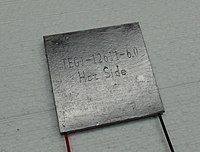
Photo from wikipedia
This study followed the approach of dispersing and localizing carbon nanotubes (CNTs) in nanostructured domains of block copolymers (BCPs) by shortening the CNTs via ball milling. The aim was to… Click to show full abstract
This study followed the approach of dispersing and localizing carbon nanotubes (CNTs) in nanostructured domains of block copolymers (BCPs) by shortening the CNTs via ball milling. The aim was to selectively tune the electrical and mechanical properties of the resulting nanocomposites, e.g., for use as sensor materials. Multiwalled carbon nanotubes (MWCNTs) were ground into different size fractions. The MWCNT length distribution was evaluated via transmission electron microscopy and dynamic light scattering. The nanostructure of the BCPs and the glass transition temperatures of the PB-rich and PS phases were not strongly affected by the addition of CNTs up to 2 wt%. However, AFM and TEM investigations indicated a partial localization of the shortened CNTs in the soft PB-rich phase or at the interface of the PB-rich and PS phase, respectively. The stress-strain behavior of the solution-mixed composites differed little from the mechanical property profile of the neat BCP and was largely independent of CNT amount and CNT size fraction. Significant changes could only be observed for Young’s modulus and strain at break and may be attributed to CNT localization and small changes in morphology. For nanocomposites with unmilled CNTs, the electrical percolation threshold was less than 0.1 wt%. As the CNTs were shortened, the resistivity increased and the percolation threshold shifted to higher CNT contents. Composites with CNTs ground for 7.5 h and 13.5 h showed no bulk conductivity but significantly decreased surface resistivity on the bottom side of the films, which could be attributed to a sedimentation process of the grind and thereby highly compressed CNT agglomerates during evaporation.
Journal Title: Polymers
Year Published: 2022
Link to full text (if available)
Share on Social Media: Sign Up to like & get
recommendations!